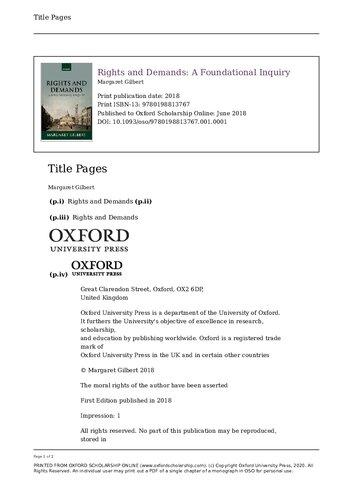Life in Groups
Life in Groups
How We Think, Feel, andAct Together
MARGARET GILBERT
Great Clarendon Street, Oxford, OX2 6DP, United Kingdom
Oxford University Press is a department of the University of Oxford. It furthers the University’s objective of excellence in research, scholarship, and education by publishing worldwide. Oxford is a registered trade mark of Oxford University Press in the UK and in certain other countries
© Margaret Gilbert 2023
The moral rights of the author have been asserted
First Edition published in 2023
Impression: 1
All rights reserved. No part of this publication may be reproduced, stored in a retrieval system, or transmitted, in any form or by any means, without the prior permission in writing of Oxford University Press, or as expressly permitted by law, by licence or under terms agreed with the appropriate reprographics rights organization. Enquiries concerning reproduction outside the scope of the above should be sent to the Rights Department, Oxford University Press, at the address above
You must not circulate this work in any other form and you must impose this same condition on any acquirer
Published in the United States of America by Oxford University Press 198 Madison Avenue, New York, NY 10016, United States of America
British Library Cataloguing in Publication Data
Data available
Library of Congress Control Number: 2022947307
ISBN 978–0–19–284715–7
ebook ISBN 978–0–19–266283–5
DOI: 10.1093/oso/9780192847157.001.0001
Printed and bound by CPI Group (UK) Ltd, Croydon, CR0 4YY
Links to third party websites are provided by Oxford in good faith and for information only. Oxford disclaims any responsibility for the materials contained in any third party website referenced in this work.
ForNat,Dave,andJosh
Preface
Acknowledgments
Sources
Introduction
I. OUR INTENTIONS, AGREEMENTS, AND RIGHTS
The Nature of Agreements: A Solution to Some Puzzles about Claim-Rights and Joint Intention
II. OUR BELIEFS
Culture as Collective Construction
Joint Commitment and Group Belief
Belief, Acceptance, and What Happens in Groups: Some Methodological Considerations
Collective Belief, Kuhn, and the String Theory Community
Group Lies—and Some Related Matters
III. OUR EMOTIONS
Collective Remorse
How We Feel: Understanding Everyday Collective Emotion
Ascription
IV. OUR PREFERENCES, VALUES, AND VIRTUES
Collective Preferences, Obligations, and Rational Choice
Corporate Misbehavior and Collective Values
Can a Wise Society Be a Free One?
V. RIGHTS AND OBLIGATIONS IN GROUP LIFE
Regarding ATheoryofPoliticalObligation
Giving Claim-Rights Their Due
Conclusion: The Conversation Continues
TopicBibliographyoftheAuthor’sWorksRelatingtoLifeinGroups
SubjectIndex
NameIndex
Preface
This book comprises thirteen essays relating to central aspects of our life in groups, along with a general introduction and a concluding discussion. A particular focus is on what we refer to as our beliefs, emotions, and plans, in such everyday statements as “We think a crime was committed,” “The team is delighted to have won,” and “We plan to go to New York in June.” It is not easy to say precisely what states of affairs “on the ground” such statements refer to.
Central to my proposals is what I refer to as joint commitment. Our having a certain plan, for instance, is our having a joint commitment with the appropriate content. Some of the essays defend specific proposals of this sort, others consider their implications in particular contexts, others explore closely related matters, including the nature and basis of the rights and obligations that are part and parcel of group life.
The individual essays are all relatively self-contained, so the reader can start anywhere in the book without reading what comes before. That said, there are clear links between many of their topics, as is reflected in the division of the book into different parts. Each essay retains its original citation style and is bibliographically complete.
The introduction includes an extended discussion of joint commitment for those who wish to approach that first, or to read more about it later. Among other things it clarifies certain points in response to questions others have posed. It concludes with a preview of the sections and chapters of the book.
The book’s conclusion introduces some further topics relating to life in groups, responds to some comments on my approach to that life, and indicates some avenues for further research.
At the end of the book there is a bibliography of my writings relating to life in groups, with the articles divided by topic, for those who wish to go further.
While most of the essays have been previously published, many of these found their original home in a collection with a particular, limited emphasis, or in a specialist journal. This is true of the discussions that constitute chapters 1 and chapter 13, among others. I hope that bringing the essays together in one volume will increase their accessibility for those with an interest in the topics they address.
Given the opportunity, I have corrected some typological errors in the originals and made some minor changes to bring out my meaning more clearly. Thus the previously published essays are best read in this new presentation.
Acknowledgments
I am indebted to all of those who have contributed to my thinking on the topics in this book over many years. Those whose input on a particular chapter has been helpful are thanked in the chapter itself.
In connection with this book my first thanks go to Peter Momtchiloff, who commissioned it for Oxford University Press, Oxford, with further thanks to all of those involved in the production process.
I am also grateful to Matthew Dean and Giulia Napolitano for helping in preparation of the manuscript, and to Tiffany Zhu for her help with the proofs and preparation of the indices.
Thanks to my students at UCI, both graduate and undergraduate, for probing discussions of many of the topics addressed, and to Jane Goldman for discussion of the project in its early stages and beyond. Thanks also to the staff of the Department of Philosophy at the University of California, Irvine for their support, including the administration of the research funds provided through my position as Melden Chair of Moral Philosophy, which have been helpful in many ways.
Special thanks to Daniel Pilchman and James Weatherall, each of whom coauthored one of the articles that now constitute a chapter of this book. I would like also to thank Maura Priest for our collaborations on several articles on themes related to our life in groups.
More generally, I am grateful to many scholars for their interest in my work over the years. In some cases they have generously encouraged me to publish criticisms of their own views—I am thinking in particular of the late David Lewis, and Thomas Scanlon.
Others have seriously engaged with my ideas, hosted or contributed to conferences for the discussion of them, and been supportive in other ways. There are far too many to list here in these connections but I should like to mention at least Donald Baxter, Paul Bloomfield, Alban Bouvier, Michael Bratman, Antonella Carassa, Marco Colombetti, Rowan Cruft, Stephen Darwall, Roberta De Monticelli, Francesca Di Lorenzo Ajello, Miranda Fricker, Itzel Garcia, John Greenwood, Gilbert Harman, Jeffrey Helmreich, Aaron James, Peter Jones, Christine Korsgaard, Saul Kripke, Noa Latham, David Lewis, Stephen Lukes, Ruth Millikan, Herlinde Pauer-Studer, Costanza Penna, Gerhard Preyer, Joseph Raz, Mark Sainsbury, Frederick Schmitt, Gopal Sreenivasan, Gabriele Taylor, Deborah Tollefsen, Michael Tomasello, Raimo Tuomela, Gary Watson, Leif Wenar, and Morton White.
I should also like to thank the American Philosophical Association for hosting several author-meets-critics sessions on my work along with other pertinent sessions at their meetings.
My work on this book took place during a worldwide pandemic. Much of my socializing has been on the phone or over the internet. I am deeply grateful to those colleagues, friends, and family members who have regularly provided conversation, consolation, and community during this time.
As always, my parents must bear the ultimate responsibility for this book as for everything I have ever done. I continue to be more than grateful to them not only for having me, but for their loving support and guidance throughout their lives.
Sources
The following articles are reprinted with permission:
‘The Nature of Agreements: A Solution to some Puzzles about Claim-Rights and Joint Intention’ (2014), in RationalandSocial Agency, eds. M. Vargas and G. Yaffe, New York: Oxford University Press, pp. 215–54.
‘Culture as Collective Construction’ (2010), and ‘Joint Commitment and Collective Belief’ (2010), in Kolner Zeitschrift forSociologie, pp. 384–410.
‘Belief, Acceptance, and What Happens in Groups: Some Methodological Considerations’ (2014) (with Daniel Pilchman), in Essays in Collective Epistemology, ed. Jennifer Lackey, Oxford: Oxford University Press, pp. 190–212.
‘Collective Belief, Kuhn, and the String Theory Community’ (2016) (with James Weatherall), in TheEpistemic Life ofGroups, eds. M. Brady and M. Fricker, Oxford: Oxford University Press, pp. 191–217.
‘Collective Remorse’ (2001), in War Crimes and Collective Wrongdoing: A Reader, ed. A. Jokic, Oxford: Basil Blackwell, pp. 216–35.
‘How We Feel: Understanding Everyday Collective Emotion Ascription’ (2014), in Collective Emotions, eds. Mikko Salmela and Christian van Sheve, Oxford: Oxford University Press, pp. 18–30.
‘Collective Preferences, Obligations, and Rational Choice’ (2001), in EconomicsandPhilosophy, vol. 17, pp. 109–19.
‘Corporate Misbehavior and Collective Values’ (2005), in Brooklyn LawReview, vol. 70, no. 4, pp. 1369–80.
‘Can a Wise Society Be a Free One?’ (2006), in SouthernJournal ofPhilosophy, vol. 44, pp. 1–17.
‘Giving Claim-Rights Their Due’ (2012), in Rights: Concepts and Contexts, eds. Brian Bix and Horacio Spector, Farnham, Surrey: Ashgate, pp. 301–23.
Introduction
Someone might say, of her family, “We intend to go to Greenland this year.” Someone might say, of her book group, “We thought that novel was far too long” or “We preferred her first book to the later ones.” And someone may say of her sports team, “We are thrilled by this result.” Such statements are completely commonplace. Call them collectivepsychologicalstatements. Precisely how they are to be understood is a matter of debate. As will become clear in the course of this book, however, there is good reason to suppose that they are not simply summaries of the intentions, beliefs, and so on, of the individual group members. Nor, indeed, do they imply that the individuals in question have corresponding intentions, and so on, of their own.
If this is so, what do these statements amount to? And how, and in what way, do the states of affairs they refer to—call these collective psychological states—impact our individual and collective lives?
The chapters of this book represent the continuation of a sustained investigation into these and related questions beginning with my book OnSocialFacts.1
0.1 The Perspective of This Book
As I attempted to formulate accounts of everyday ideas of our acting, intending, and thinking, going on to our preferring, valuing,
and feeling, among others—considering them one by one—a pattern began to emerge.2
An important clue was this: a particular set of rights against each other are understood to accrue to the parties to a given collective goal, intention, and so on. These are rights to actions and utterances that promote the collective goal, are expressive of the collective intention, and so on. Corresponding to and, indeed, equivalent to these rights are obligations to the right-holders to perform the relevant actions.
Thus suppose that we intend to eat together at six o’clock this evening. I then have a right against you that you don’t do something to make it impossible that we eat together at six. You, meanwhile, have a corresponding obligation to me not to make it impossible for us to eat together at six.
The understanding that there are such rights and obligations is indicated by the rebukes and demands that may be issued when other parties to a collective action, say, speak or act in ways that are likely to undermine the success of the action. So, for example, one member of a hiking group that is intent on climbing a particular hill before turning back might call to another in a demanding tone, “Hey, if you don’t speed up we won’t get back before dark!” implying a right to the slower hiker’s moving more quickly.
What grounds these rights and obligations? This question, among others, led me to the idea that lies at the heart of this book.
To put things generally: as they are—implicitly—conceived of in everyday life, the different components of our collective psychology —our intending, thinking, and so on—have a particular structure.3 I describe this structure as a joint commitment of the two or more people involved, the content of the joint commitment being appropriate to the case in hand. Take our collective intention to go to Europe this year. I suggest that—in technical terms that will be explained below—for us to have this intention is for us to be jointly committed to intend as a body to go to Europe this year.
Joint commitment features in every chapter of this book, along with such explanation of its nature and functioning as is sufficient for
the chapter’s purposes. The next section of this introduction offers an overview of some key points, followed by some elaborations that may be useful before, or after, reading an individual chapter.4
0.2 Joint Commitment
To be jointly committed in the sense at issue here two or more people must be in a particular condition that is the product of a particular process. In spelling this out further I start with the product.
0.2.1 The Product
When two or more people are jointly committed in some way, they are committed as one. In emphasizing “as one,” I mean to draw attention to the fact that the subject of the commitment—the “one” whose commitment it is—comprises those two or more people.
The parties’ being jointly committed is a normative matter: it concerns what they oughtto do, all else being equal. The “ought” in question is not a specifically moral one, but it implies that any actions contrary to it will be at fault, all else being equal. It is an exclusionary “ought,” in the sense that some kinds of consideration that point against it are not properly judged to license contrary action. In this case a person’s contrary inclinations and desires, as such, do not count against the “ought” in question. Moral considerations, however, may do so.
Thus even though, all elsebeingequal, I ought to conform to a joint commitment, it may be that, allthingsconsidered, I ought not to conform to it. This may be so if, for instance, the joint commitment enjoins actions that are morally impermissible, or if conformity to an otherwise innocuous joint commitment is expected
to lead to consequences dire enough morally to require nonconformity.
Given that they are jointlycommitted with certain others in some way, each of the individual parties is committed to act in ways that will promote fulfillment of the joint commitment. These individual commitments depend on the joint commitment for their existence: they last as long as it does. By this I mean that each party continues to be (individually) committed to act in ways that will facilitate fulfillment of the joint commitment. Depending on the circumstances, my own more specific commitments or subcommitments may change, as may yours.5
0.2.2 The Process
The process of joint commitment is broadly speaking psychological. It has two variants: the basic and the non-basic or authorityinvolving cases.
0.2.2.1 The Basic Case
In the basic case, in terms to be explained, each of the would-be parties have openly expressed their readiness to be jointly committed in a particular way with the relevant others, as is common knowledge between the parties. As the parties understand, once this condition is fulfilled, they will be jointly committed in the way in question.6
A state of affairs is common knowledge between two or more people if and only if, roughly, it is entirely out in the open between them.7 People express their readiness openlyif they intend, or are at least prepared for it to be common knowledge among the relevant others.
Note that, in the above account of the basic case, what is at issue is not only behavioral expressions but also something that is
expressed: actual readiness on the part of each for the relevant joint commitment to be established. One may wonder how the “inner states” of the parties can be open to all. One might allude to the philosophical problem of other minds—can one ever know what is in them? Suffice it to say, here, that I take there to be many contexts in which one person knows of another’s actual readiness for a given joint commitment, or, indeed, where that readiness is common knowledge among all concerned.8
As I understand it, the readiness in question can exist in circumstances of strong external pressure. For instance, one may be ready to commit oneself in a certain way as a result of threats to one’s person. As long as one prefers to make the commitment to experiencing the expected penalty for not doing so, one can be ready to do so in the sense at issue. It follows that the fact that two or more people are jointly committed in some way does not mean that the circumstances in which their joint commitment was formed are morally impeccable.
The conjunction of expressions of readiness for joint commitment may amount to an agreement, but need not.9 Nor need the individual expressions of readiness amount to promises, which people often—if wrongly see as the constituents of an agreement.10 Nor need words be involved. Consider, for instance, the case in which Isaac sees Maria struggling to lift a heavy suitcase into her car, and rushes to help her. In a situation like this the protagonists may establish a joint commitment to, in my technical language, endorse as a body a particular goal without any preliminary verbal exchange.11
Note that I am not supposing that each party is indicating that their personal readiness for joint commitment is conditional on the readiness of whichever others.12 Rather, as is understood by the parties, if and only if they all openly express their unconditional personal readiness to be jointly committed with the others, in conditions of common knowledge, the joint commitment of them all will be established. There is, then, no “deconditionalization problem,” as there would be if what each party expressed was, for instance, “I
am ready for us to be jointly committed, if you are similarly ready,” leaving us with two conditional expressions of readiness, requiring of at least one party a further move.13
An important kind of basic joint commitment is involved in what I have referred to as a moment of mutual recognition.14 Here, in effect, the parties have expressed their personal readiness to be jointly committed to acknowledge as abodytheco-presence ofthe parties as when one person “catches the other’s eye.”15 Mutual recognition in this sense may be established before, or at the same time as, the establishment of further joint commitments.16
The parties to a given joint commitment do not have to be present to one another when making the relevant expressions. They must, however, be directing these expressions toward one another at the level of their intended target or targets.17 Further, the parties need not know one another personally, or even knowofone another as particular individuals as opposed to, say, “one of those living on this island.”
In relation to the last point it is important to note that in situations in which the parties do not, in general, know of one another as particular individuals, there can be common knowledge in the population in question that the relevant expressions have been made by the members of that population characterized as such. I have elsewhere referred to such common knowledge as population commonknowledge, as opposed to individualcommonknowledge.18
Evidently, it may take some time for a given basic joint commitment to be established, even when the parties are face to face, and even when an agreement seems to have been made. The meaning of a word or gesture may need to be clarified; it may take a while to discern how many have made the relevant expressions, and so on.
In sum, a basic case of joint commitment can be established without words, in the absence of any promise or agreement, among people who do not know of one another, let alone knowing one another, and over an extended period of time. The fact that a case
of joint commitment is a basic case, then, does not mean that its establishment has been a quick or simple matter. It is in part for this reason that non-basic cases are an important part of the landscape of joint commitment.
0.2.2.2 The Non-Basic Case
In the non-basic or authority-involving case, a joint commitment is established by some person or body of persons that has been authorized, through a basic joint commitment of the parties, to establish further joint commitments of them all. Such authorization may restrict the scope of the non-basic joint commitments that the authorized person or group can establish, as it may restrict the contexts and methods of their establishment.
An important aspect of the distinction between basic and nonbasic cases is as follows. In a basic case those who are jointly committed will know that they are committed in the relevant way. In a non-basic case they may not know this—though of course they may. So—in what I take to be a reference to a non-basic joint commitment a man may say to his wife, “Whose parents are we visiting this Christmas?” understanding that she is the one who makes their decisions on such matters, and that she will have made that decision by now, though she has not communicated it to him.19
0.2.3 Regarding a Possible Query
One may wonder how two or more people could impose a normative constraint upon those two or more people in the way proposed. In particular, one may wonder how the fact that the relevant individuals will the desired normative result—all expressing their personal readiness for joint commitment—can impose a normative constraint on them as one. It has been argued, indeed, that individuals lack the analogous normative power over themselves, at least when they also have the power to reverse themselves.20
Such arguments come up against what I take to be our everyday understandings.21 That said, what is most important for an understanding of our collective psychology is the collective case, which has not been the target of the arguments just referred to, and appropriately so. The collective case is importantly different from the individual case, with respect to both its genesis—in the matching expressions of two or more wills—and its conclusion, to which I now turn.
0.2.4 The Conclusion of a Joint Commitment
Once a joint commitment has been fulfilled, it is over and done with. But how might it otherwise properly be concluded?22 There are several ways in which this can happen. Before saying more about this, let me make a related point.
Those who are jointly committed immediately prior to the conclusion of the commitment need not be identical to those who created that joint commitment in the first place. Consider, for instance, that people can co-create a joint commitment in their capacity as possessors of a certain general property, e.g., “person living on this street,” and some may cease to hold that property—by moving house or, for that matter, by dying. Further, people who were not among the co-creators can “sign on” to a given joint commitment, as when a new arrival is welcomed by the original parties, or by their representative, acting in the name of them all.23
That said, all of those who are jointly committed at the timethe commitment isconcludedmust have been involved in its conclusion in one way or another in order for it to have been properly concluded.
As with the creation of a joint commitment, we can distinguish basic from non-basic or authority-involving cases with respect to its conclusion.
In a basic case, all parties must express their personal readiness to conclude the commitment, in order that it be properly concluded. Such expressions can take a variety of forms.
Among these is participation in deliberate, explicit rescission, as by an agreement to conclude the joint commitment. There is also what I’ve referred to as “fade-out,” in which the readiness of each party is established tacitly over what could be an extended period of time.24 Another possibility is a more precipitous kind of “voting with one’s feet,” as when, without prior discussion, each of the crew members jump out of a sinking ship.
Though in principle all parties must make the relevant expressions, fewer than that may be taken to have concluded the commitment in practice—particularly if there is no hope now of fulfilling the commitment. Suppose, for instance, that fulfilling the commitment requires that appropriate actions of all five parties be performed. If one party leaves the scene, the other parties may reasonably take it that their joint commitment is at an end.
In a non-basic case, the joint commitment is concluded by a person or body authorized by the parties to do so. I take it that, though authorized to instigate a particular joint commitment, a given person or body of persons may not be authorized unilaterally to rescind or change it, but some other person, or body of persons, may need to concur as to any rescission or change.
Similarly, certain people might together create a given joint commitment, but authorize one of them unilaterally to decide on its rescission prior to fulfillment. This could happen when one person is known to be reluctant to be beholden to the others for rescission. So the members of a group aiming to scale a particular mountain may say to the least experienced climber, “We’ll stop as soon as you want: just say the word.”
It is important to note that the implicit content of a joint commitment may be such that what may look like unilateral rescission—involving, perhaps, a simple announcement that one is moving on—is no such thing. So consider the case in which the parties understand the goal they are jointly committed to espousing
as “walking alongside each other for as long as it suits us both,” or “playing around with a football as long as each of us feels like it,” as opposed to “going for a walk together” or “playing a game of football.” If one of the parties stops and says, “I’m off now!” without any “by your leave,” this will, predictably, ruffle no feathers.
0.2.5 The Content of a Joint Commitment
As indicated earlier, the content of any joint commitment can be represented by a particular schema, which I shall refer to here as SJC. To make this concrete I start with one instance:
Jack and Jill (or: members of G, as such) are jointly committed to espouse as a body the goal of painting the house.
Generalizing now, one can represent any joint commitment as follows, where “phi” stands for a psychological state such as espousal of a particular goal, belief in a particular proposition, acceptance of a proposition, and so on:
[SJC] Persons X, Y, and so on (or: those with feature F) are jointly committed to phi as a body.
The joint commitment is, as said, a commitment of persons X, Y, Z, and so on (or those with feature F) as one. They are committed, as one, to phi as a body.
Some commentators have seen the phrase “as a body” in Schema SJC as qualifying “joint commitment,” but that is not how I understand it. Any joint commitment does, of course, combine the individuals in question into what might be thought of as a body of sorts. They are, after all, committed as one. And in one of my earliest writings on the subject I spoke of people being “committed as a body” rather than as jointly committed.25 That said, in Schema
SJC, and its particular instances, I understand “as a body” as qualifying “phi.”
Further, though many commentators seem to have left the matter there in their minds, I have regularly made it clear that I understand the phrases “to espouse goal G as a body,” and so on, as shorthand for something else.
In one formulation, those who are jointly committed to phi as a body are—more fully—jointly committed to emulate, by virtue of their several actions and utterances, a single phi-er, for instance, a single espouser of goal G. In other, more nuanced, words, they are jointly committed to speak and act, in relevant circumstances, as if they were the representatives of a single espouser of goal G. Thus if Jack and Jill are jointly committed to espouse as a body the goal of painting the spare room this weekend, they are to speak and act, in relevant circumstances, as would the representatives of a single possessor of that goal.
Note the qualifier “in relevant circumstances.” Suppose that Jack and Jill are jointly committed to espouse as a body the goal of painting the spare room this weekend. This means that they need to speak and act as would the representatives of a single espouser of that goal when conversing and otherwise interacting with each other, without preamble, or when representing the two of them to a third party. If, however, Jill’s friend Babs asks her what she is doing that weekend, Jill can appropriately speak for herself, as in “I’m helping Jack paint the spare room.” She may, of course, say, “We are painting the spare room,” thereby speaking as a representative of herself and Jack.26
0.2.6 Joint Commitment, Rights, and Obligations
It can be argued that once a joint commitment is established, the parties have rights against each other to conformity with it. One’s
right against another, in the sense in question, is equivalent to that other’s obligationtooneself.27
It is important to note that to say that those who are jointly committed in some way oughtto conform to the joint commitment is notto say that they are obligatedtoone anotherto do it. Nor does it follow from the fact that they ought to act accordingly that they are obligated to one another so to act. In sum, to say something of the form: “John ought to perform action A” is neither to say nor to imply that John is obligatedtoanyone to do A.
That said, it can be argued that, by virtue of the process of joint commitment, not only ought the parties conform to the commitment, all else being equal, but they are obligated to each other so to conform. The argument for the latter point appeals to the normativity of joint commitment—to the fact that each member ought to conform—but does not stop there.
28
It can be argued, then, that if the elements of our collective psychology—our intentions, beliefs, attitudes, emotions, and so on, as understood in everyday life—are founded in joint commitment, the origin of the associated rights and obligations has been found. I believe that they are, and it is.
The rights and obligations of joint commitment might possibly be referred to as “social” rights and obligations, though that may be too broad a characterization to be helpful. I propose that they are not, in any case, best thought of as moral rights and obligations. This fits the observation that, apparently, the rights and obligations associated with our collective intentions, and so on, can be rights to actions it is morally impermissible to perform, all else being equal.29 This observation is suggested by the classic phrase “honor among thieves.”
It is also consistent with the idea that joint commitment thinking is prior to at least some aspects of moral thinking in human evolution and has, to some extent at least, prompted such thinking.
30
If it is best not to characterize the rights and obligations of joint commitment as moral, one can conclude that there is a third realm
of rights distinct from the two that have been the focus of traditional rights theory: the moral and the legal realms.31
Evidently pursuit of an understanding of our everyday psychological statements can bear unexpected fruit, relating as it does to the theory of rights and directed obligations, and the scope and evolution of moral thinking, among other significant topics.32
0.3 A Note on Groups
The term “group” and even the more qualified “social group” has been used in a variety of more or less restrictive ways, both in everyday speech and in theorists’ discussions.33 This can be seen from the variety of items that may be listed as “groups” or “social groups” by a given theorist, who then goes on to make various generalizations about groups, or distinctions among groups, in light of the list in question.
Thus, one list of “groups of people” includes “classes, populaces, mobs, legislatures, courts, faculties, student bodies, and so on,” adding shortly after “kindergartners” and “legislators.”34 And another list of “social groups” of one sort or another includes “racial, ethnic and gender groups” along with families, teams, clubs, among other examples.35
There is no need to argue, here, for the correctness or otherwise of the inclusion of a given item in one of these lists, or, for that matter, to argue that one or more further items or kinds of items should have been included from some particular point of view. The main thing, for present purposes, is to establish the rough contours of “groups” in the sense of this book.
Early on, in thinking about groups, or social groups—I tended to use the latter phrase—I appealed to some lists which appeared to be at least roughly right for my particular purposes. These include the following from the great sociologist Georg Simmel, in which he gives as examples of “sociation” “getting together for a walk … founding a
family … the temporary aggregation of hotel guests,” and “the intimate bonds of a medieval guild.”36
I also invoked some suggestive yet puzzling general statements from Simmel and another of the founders of sociology, Émile Durkheim, regarding the nature of groups. These included Simmel’s tantalizing claim that a society is an “objective unit” of a special kind, such that “the consciousness of constituting with the others a unity is actually all that there is to that unity.”37 And Durkheim’s equally tantalizing reference to a society as a “suigeneris synthesis of individuals.”38
Both of these references connect the idea of a society or social group with the idea of a special kind of unity of persons—a unity going beyond the possession of common features. They connect in particular with something that might be expected to be an appropriate reference for a full-blooded use of the collective “we.”
Here I mean to contrast the use of “we” in question with uses one might call “initiatory,” “tendentious,” or (more positively) “aspirational.”39 Clearly, this is not true of all of the examples of groups or social groups from which one or another contemporary theorist has started.
In any case, in the present volume, what is key is groups, social groups, or, if you like, populations, of the kind with a collective psychology—those to whose members psychological predicates are standardly ascribed in a straightforward manner, using a full-blooded collective “they” or “we.”
0.4 Plural Subjects
I should say something here about my technical phrase “plural subject.”40 As I understand it, a pluralsubjectis, by definition, a set of people who are jointly committed with one another in some way. As I understand it, then, a joint commitment account of some element of our collective psychology—as understood in everyday life
—does not bring with it any suspect appeal to a “group mind.” In particular it does not bring with it any reference to any “subject of consciousness” other than the individual persons involved.
I tend not to write of “plural subjects” now because of misunderstandings along these lines. However, once the phrase is properly understood it presents a useful, compact way to refer to a set of people who are jointly committed with one another in one or more ways. Thus, interpreting “plural subject” as indicated, I have suggested that social groups—of the type at issue here—are plural subjects.41
Given that a plural subject is comprised of the parties to one or more joint commitments, and that the parties to a particular joint commitment may change, by addition or subtraction, the members of a plural subject can change. A plural subject account of social groups, then, can accommodate the intuitive point that it is possible for a social group to persist through a change in its members.
0.5
Regarding an Appeal to Joint Commitment
Different accounts of particular collective psychological states may have different targets. Some, for instance, may want to explain what it would be appropriate to call a “collective belief,” given certain antecedently established standards for what constitutes a belief of any kind.42 In contrast, my aim has been to elucidate everyday ascriptions of such states.
Some may think an appeal to joint commitment cannot be right in this context, since “joint commitment” is a technical term, and one cannot expect those who use the language I am trying to understand to have a grasp of that. One can, however, possess a concept or grasp a point without being able to articulate it.
Some may object to an appeal to joint commitment on the grounds of theoretical parsimony: why invoke this concept when
other, more familiar concepts, such as that of a personal intention, or goal, can do the job?43 Let us grant that sticking with existing concepts in our theories is a virtue—the virtue of theoretical parsimony when the job in question can be done with those concepts. But what if it can’t—as appears to be the case here? What if an appeal to joint commitment is the best way to understand our collective psychological states—as understood in everyday life?
Further, if we need to appeal to joint commitment in connection with other everyday concepts, it is not clear how much is gained by eschewing the idea of joint commitment in relation to collective psychological states as conceived of in everyday life. If, as I have argued, we need to appeal to joint commitment in order to give an account of everyday agreements as these are ordinarily conceived, there seems to be little benefit in avoiding it in accounting for other everyday concepts.44
Subsequent to my introduction of joint commitment into the discussion of collective psychological states and other social phenomena, empirical studies in developmental psychology have indicated that human children evince an understanding of, and capacity for, joint commitment from an early age.45 These studies clearly support my contention that the concept of a joint commitment is a fundamental part of the conceptual equipment of human beings. Indeed, some primatologists have recently argued for an understanding of joint commitment in some non-human primates.46
Clearly, collective psychological states, understood in terms of the relevant joint commitments, are extremely consequential phenomena. One need only point to their unifying power—unifying disparate individuals into one “we”—and their inherent stability— which comes from several quarters, including the associated standings to issue demands and rebukes to other parties, and the conditions on rescission.
Joint commitments do not necessarily promote the good. Irrespective of the contexts in which they are formed—which may involve the intimidation of one person by another, for example—their
content may be suspect. Further, just as they bind us together, they divide “us” from “them” in ways that are relatively hard for any one of us to change.47 As the essays gathered together in this book make clear, we need to make our joint commitments wisely, support them appropriately, and change them when change is called for.
0.6 Preview
The individual chapters of this book are presented in five parts. This preview includes an introduction to each part and a summary of each chapter in that part. This should enable readers to focus on the chapters that most interest them, while retaining a sense of each chapter’s place in the overall scheme of the book. After the Conclusion at the end of the book there is a list of my publications on our collective psychology and other central aspects of life in groups, divided by topic for ease of reference.













